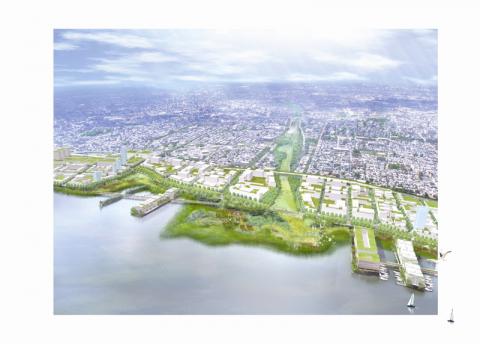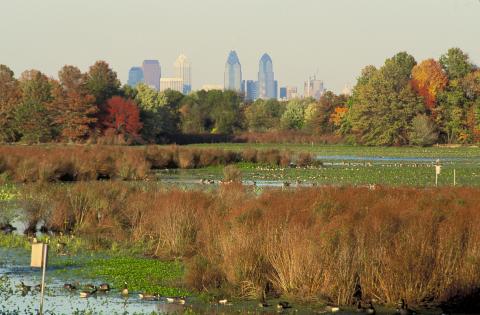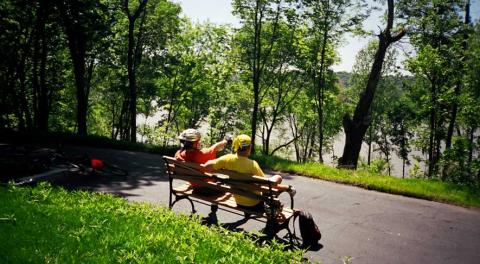Stuart Weitzman School of Design
102 Meyerson Hall
210 South 34th Street
Philadelphia, PA 19104
Get the latest Weitzman news in your Inbox
“This is a long-term issue, but I think needs to be in people’s minds as well—and that is climate change, sea-level rise and the risk of flooding. A ‘softer’ approach to development and allowing for wildlife habitat could stem that tide. The revival of wetlands along the shoreline could provide a buffer area for flooding.”
Barry Seymour, executive director, Delaware Valley Regional Planning Commission (75)
Walk along the edge of the central Delaware today and you will see cement, trash and the occasional floating shopping cart. You will not see river plants, fish or other signs of a healthy river.
Cleaning and planting the river’s edge will increase the area’s attractiveness to residents, business owners and tourists. In addition, a healthy river’s edge prevents flooding, cleans local air, improves water quality and protects the health of those who live in river neighborhoods. A healthy river’s edge will give Philadelphia a new reason to be proud of its river.
The first step toward creating a healthy river’s edge is to clean up the years of accumulated trash dumped in the water and at the water’s edge and replace the garbage with trees, shrubs and grass wherever they can withstand the force of the river flow. Reconstructing destroyed river wetlands is also critical for two reasons: because wetlands are where thousands of types of fish, birds and other wildlife live, and because wetlands remove dangerous toxins from polluted river waters naturally. Another critical task is to begin to naturalize shorelines where old steel or concrete bulkheads are crumbling and no longer effective by replacing them with sand or rock beaches that will stop erosion, allow the greenway to filter pollution more effectively and allow people to touch the water. Finally, we need to reduce and divert combined sewer overflows that allow sewage to flow directly into the river when the combined sewer system exceeds its capacity after a storm.

Each of these actions will lower pollution, improve habitat for fish and birds, help manage stormwater and create a healthier, more beautiful river’s edge:
Clean the river’s edge. With the help of Philadelphia Water Department trash boats, Fairmount Park Commission staff and hundreds of volunteers, remove trash from the river’s edge. Pick up litter and garbage. Remove furniture and other items that have been dumped into the water. Create a trash-free river’s edge.
Restore plants to the riverbank. Trees and plants work hard along the river’s edge to filter pollutants, absorb stormwater, beautify the landscape and create habitat for birds and other river animals. Wherever we have the land to preserve a greenway along the river’s edge, plants will line the shores. At locations where a 100-foot greenway is not possible, a narrow line of native plants can still beautify the riverbank. Some pier sites will not have any riverbank areas for planting. These sites will be priority targets for reconstructed tidal wetlands—underwater planted areas.
Reconstruct river wetlands (76). Wetlands, the shallow areas where land meets water, once lined the banks of the central Delaware. Less than 5 percent of the Philadelphia area’s original wetlands remain today (77). Yet wetlands play the crucial role of filtering pollutants out of the water, a service that has been valued at $1 million per mile (78). Wetlands are home to thousands of plants and animals, so by reconstructing wetlands as a part of a plan set out by the Philadelphia Water Department, we can bring many species of fish, oysters and shore birds back to the river. The Philadelphia Water Department has created a list of priority sites for wetland reconstruction, restoration and enhancement along the central Delaware, which includes structurally deficient piers. Structurally deficient piers provide exciting opportunities to create wetlands, as native wetland plants can extend from the water to the pier; thus nature can reclaim the pier. Several publicly owned piers can be used to demonstrate how beautiful and effective these wetlands can be. Private owners may be interested in donating or leasing their structurally deficient piers to the Water Department for wetland creation in exchange for the city assuming liability for the pier.
Wetland credits will allow the restoration or construction of many river wetlands to be privately funded. The federal Clean Water Act requires anyone who places fill material in a wetland area to restore wetlands or construct new ones at their own expense (79). In the last months, several developers have called city agencies and river nonprofits to shop for a compensation wetland site. “Compensation wetlands,” constructed to make up for the permitted loss of another wetland, are often called wetlands credits. Because many property owners along the central Delaware need wetlands credits, private entrepreneurs, city agencies and nonprofits can all invest in producing wetlands, which they can then sell to owners in need of compensation wetlands. This means that wetlands will be constructed at private expense. In addition, where the agreement made with a property owner requires it, the long-term maintenance costs for the site will be covered as well. So one important action step for Philadelphia is to evaluate available sites more extensively and to have sites ready for wetland construction when a developer calls and asks for a site. The Philadelphia Water Department (through its Tidal Wetland Registry) and the Pennsylvania Environmental Council are both working toward this goal. At the present time, it is far easier to build new wetlands on the New Jersey side of the river, but we need them right here in Philadelphia.
Naturalize shorelines. The majority of the central Delaware is separated from land by concrete or steel bulkheads. These bulkheads were built based on the best erosion and stabilization technology of the nineteenth and early twentieth centuries. Today, however, scientists and river users prefer natural shorelines for river areas that are not in a main shipping channel because they look more natural and attractive, restore fish habitat and improve water quality (80). Bulkheads have a limited lifespan of about fifty years, and many of the Delaware River bulkheads north of Center City are made of wood and were installed in 1909 (81). The cost to replace one linear foot of bulkhead is $7,000 to $10,000 (82). This substantial cost alone may encourage property owners to replace bulkheads with natural shoreline (83). A natural shoreline is currently being installed along the Harlem River, with a green seawall made up of stacks of steel-cage containers that are filled with soil and plants (84). A protective breakwater of rock can be seeded with oysters and installed in shallow water to protect the shoreline land and habitat from waves. Where bulkheads are for the most part intact, wetland plants can be placed into the holes and cracks within the bulkhead surface to create a seawall made up of a combination of plants and hard materials.
Reduce, filter and divert combined sewer overflows to create a healthier river’s edge. As is true in many older cities, Philadelphia’s combined sewer system, which carries both stormwater and sewage, discharges wastewater into the Delaware when a storm overwhelms its capacity. These combined sewer overflows, or CSOs, threaten the health of the river’s edge, produce unsightly trash and allow sewage and other pollutants to enter the river. The Philadelphia Water Department is working on long-term solutions to this problem, including the construction of wetlands to filter out the pollutants. In the short term, the health of the river’s edge can be improved by diverting CSOs farther into the river and away from the river’s edge. Distributing CSOs into the deeper, flowing region of the river can create a cleaner river’s edge, one where native plants, fish, shellfish and birds can once again begin to thrive.

Tinicum Marsh, the largest freshwater tidal wetland in Pennsylvania, is a significant naturalized habitat along the Delaware River, outside the project area.
Short-Term Actions
- Organize a river’s edge clean-up day and make it an annual Philadelphia tradition.
- Explore the feasibility of a natural living shoreline initiative for the central Delaware similar to the Harlem River effort.
- Plant shrubs and grasses along the river’s edge in places where land is insufficient for a greenway and not actively eroding or armored by bulkhead.
- Use developer wetland-mitigation funding to reconstruct three demonstration wetlands on priority sites identified by the Water Department’s Tidal Wetland Registry.
- Create a convenient process through which developers can fund and achieve compensation for wetland reconstruction.
- Assess bulkhead condition along the shore and choose priority sites for creating a naturalized shore (places where the bulkhead is in poor condition and the site is outside of the shipping channel and not subject to significant waves).
- Extend CSO pipes at new development sites so that overflowing sewers do not empty at the river’s edge.
- Identify deficient piers that can be naturalized with wetlands around and under them. Funding is allocated in the city’s capital budget for identifying deficient piers.
- Approach owners of dilapidated, privately owned piers and ask if they are interested in leasing or donating piers to the city’s Water Department in exchange for the city assuming liability and providing maintenance.
Longer-Term Actions
- Plant the riverbanks with native plants in areas where there is insufficient land for a greenway.
- Restore and reconstruct additional wetlands.
- Naturalize shorelines by removing or planting over cracked and broken bulkheads to allow water filtered on land to flow into the river.
- Create signage and a lesson plan for students to allow them to track the changes in water quality, fish and birds as well as other improvements to river health as a result of these actions.
- Implement the Philadelphia Water Department’s Combined Sewer Overflow Long Term Control Plan (CSOLTCP) in order to reduce overflows.
Civic Actions: What Philadelphians Can Do
- Organize large-scale, citizen-led cleanups of the river’s edge.
- Help plant native grasses, plants and shrubs along the river’s edge.
- Work with the city and the waterfront manager to stop people from dumping trash into the river.
- Partner with the waterfront manager to help maintain the greenway.
Benefits and Impact
Economic: Improves the riverfront’s attractiveness to investors, raises property values and creates potential for increased fishing, boating and other water recreation.
Environmental: Cleans up the river’s edge, restores habitat and brings fish and migratory birds back to the river.
Community: Cleans up the river’s edge, improves community pride, creates the opportunity for visitors and residents to understand and appreciate wetlands and contributes toward community beautification.
Impact on City Budget—Wetlands: The city may be able to create wetlands at very little cost. Some property owners are seeking compensation wetland sites and will pay the full cost of construction. One estimated cost for the creation of a wetland from PennDOT is about $4,000 per acre.85 PennDOT notes, however, that wetland reconstruction by a nonprofit that requires the subcontracting of design, construction and monitoring activities can cost as much as $40,000 per acre.
Impact on City Budget—Natural Shoreline: Along the Harlem River shoreline within Harlem River Park in New York City, steel bulkheads are being replaced by natural shorelines. The cost to replace steel bulkhead is $7,000 to $10,000 per linear foot. The cost to remove the bulkhead, excavate and put in a new foundation and a natural shoreline on the Harlem River was $8,000 per linear foot (86). At Louisville, KY’s 120-acre Waterfront Park, which was built on former industrial land, natural shoreline installation cost $100,000 per linear mile of riverfront. Louisville used a wire mesh holding topsoil, rock and plantings of native riparian species to provide support and erosion control (87).
Other Cities Have Done It - We Can Too
Although cleaned-up riverbanks and wetland restoration are not the first things that come to mind when you think about tools to create economic growth, in cities across the United States, environmental improvements along major bodies of water have drawn people, commerce and development back to waterfront districts. Chattanooga, TN’s 21st Century Waterfront project, which is credited with revitalizing that city, prioritized cleaning and greening the polluted river. The city restored riverbanks, reconstructed wetlands and built a suspended boardwalk over the wetlands that students and visitors use to see wildlife that has come back. The city of Louisville, KY, installed a combination of rock and native plants along its 120-acre Waterfront Park that allows people to sit at the water’s edge for the first time in years. Natural shorelines are also emerging on the Chesapeake Bay in cities such asAnnapolis and are planned for Lardner’s Point along the north Delaware. InHartford, CT, the river cleanup has created a vibrant riverfront that has generated more than $19 million in economic activity for the region and brought fishing tournaments to the area, a major tourist attraction.

Louisville, KY
Funding Resources
Wetland Credits: Owner pays for construction of wetlands to compensate for those destroyed elsewhere.
Wetlands Protection Development Grants (EPA): This program funds wetland protection, restoration or management; $750,000 is available for three to eight grants. Typical awards range from $25,000 to $350,000.
National Coastal Wetlands Conservation Grants Program (U.S. Fish and Wildlife Service): This program funds the acquisition, enhancement and restoration of coastal wetlands. In 2008, $20.5 million in grants went to 29 conservation projects encompassing nearly 10,000 acres of coastal wetlands.
National Marine Fisheries Service Habitat Program: This funds wetland rehabilitation, streambank stabilization and spawning habitat for fish. Matching funds of at least 50 percent are required. Up to $300,000 is granted yearly for up to two years.
Aquatic Ecosystem Restoration (Army Corps of Engineers): Design and engineering assistance is given to restore degraded aquatic ecosystems. Fully pays for feasibility study but requires a local match for design and construction costs.
Partners for Fish and Wildlife (U.S. Fish and Wildlife Service): Funds are available for the restoration of degraded wetlands, river corridors and fish and wildlife habitats.
